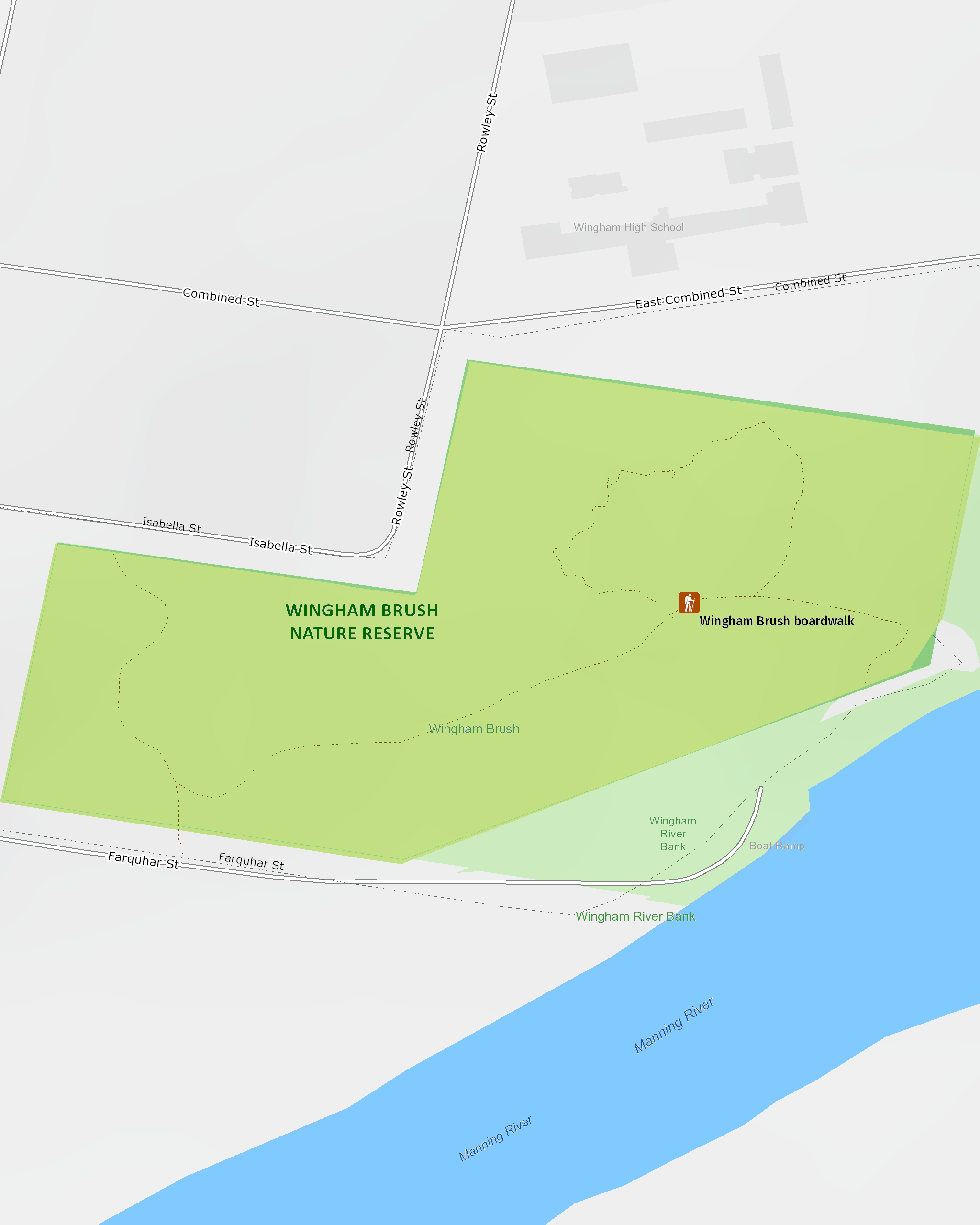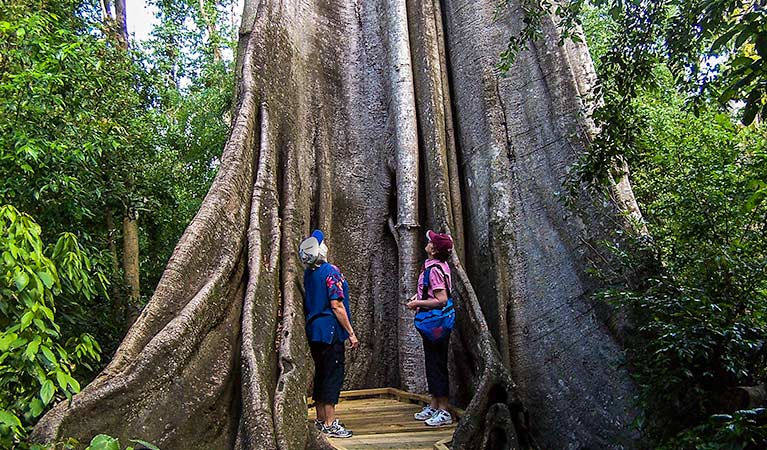Wingham Brush Nature Reserve
Overview
Wingham Brush Nature Reserve near Taree on the Mid-North Coast, makes a great family day trip or school excursion. See grey-headed flying-foxes, enjoy birdwatching and easy walking in the rainforest.
Read more about Wingham Brush Nature Reserve
Located beside Manning River, just near Taree on the Mid North Coast, you’ll find an oasis of subtropical lowland rainforest at Wingham Brush Nature Reserve. It provides a fantastic day trip and excursion for the whole family.
Also known as ‘The Brush’, this reserve preserves one of only a few remnants of this rare rainforest type in Australia, and is a significant roosting and maternity site for the vulnerable grey-headed flying-fox. Stand under the canopy and you’ll see hundreds of flying-foxes hanging above you.
Wander along the wheelchair-accessible boardwalk and follow easy walking tracks to discover the vibrant life under the canopy. There are great opportunities for photography and birdwatching, and lovely places to picnic by the river nearby. Don’t miss the spectacular show at sunset, when all those flying foxes glide overhead in search of food.
Local alerts
For the latest updates on fires, closures and other alerts in this area, see https://www.nationalparks.nsw.gov.au/visit-a-park/parks/wingham-brush-nature-reserve/local-alerts
Contact
- in the North Coast region
Wingham Brush Nature Reserve is always open but may have to close at times due to poor weather, flooding, or for the benefit of the flying foxes during breeding.
-
-
Taree office
02 6552 4097
Contact hours: Monday to Friday, 9am to 4.30pm. - 78 Hargreaves Drive, Taree NSW 2430
-
Email: npws.manninggreatlakes@environment.nsw.gov.au
-
Taree office
Visitor info
All the practical information you need to know about Wingham Brush Nature Reserve.
Map

Map legend

Maps and downloads
Nearby towns
Wingham (1 km)
A short stroll from the centre of Wingham is Wingham Brush Nature Reserve. Here you'll see a major colony of grey-headed flying foxes hanging head-down in the canopies of 1000-year-old Moreton Bay and strangler figs.
Taree (13 km)
Taree is a major mid North Coast city, ringed by superb beaches. It's situated on the Manning River and set against rolling hills.
Forster (46 km)
Dominated by water sports Forster is the centre of the Great Lakes area.
Learn more
Wingham Brush Nature Reserve is a special place. Here are just some of the reasons why:
Unique rainforest

Wingham Brush is an endangered rainforest community and one of the few remnants of subtropical lowland rainforest in Manning Valley. It has at least 195 species of native plants, including 76 species of trees and 32 different vines. Wander along the boardwalk and you'll see impressive trees like the gigantic Moreton Bay figs, giant stinging tree and shiny-leaved stinging tree.
The Wingham Brush method

Wingham Brush was once pristine rainforest but under European settlement, the area was selectively logged, especially for red cedar. You can still see the remains of two saw pits today from the mid-1800s. Fortunately, in 1909, it became a reserve, with the historic wharf on Manning River. But by 1980, the rainforest was infested with weeds, which threatened its very survival. Thanks to the dedication of the Wingham Brush regeneration team, and what is now internationally recognised as 'The Wingham Brush method', the rainforest has since been regenerated and returned to its natural state.
Friendly flying foxes

Wingham Brush is the only known continuously occupied roosting and maternity site for the vulnerable grey-headed flying fox between Bellingen and the Hunter Valley, peaking at over 200,000 flying foxes in the warmer months. They roost by day and fly out at night to feed. Guided in the dark by excellent eyesight and sense of smell, they forage for up to 40km from their roost. Sit by the banks of the river at sunset and you'll see this spectacular sight as they fly out in search of food. Fans of other flying things will love bird watching here too You'll find over 100 bird species here, including the osprey, black-necked stork or jabiru and wompoo fruit-dove.
- Grey-headed flying-fox live cam Get a glimpse into the world of threatened grey-headed flying-foxes at Wingham Brush Nature Reserve. Watch our bat cam live stream any time from dawn to dusk.
- Wingham Brush boardwalk Wingham Brush boardwalk connects several walking tracks for a wheelchair friendly experience in the rainforest. Enjoy birdwatching and see a grey-headed flying fox roosting site.
- Wingham Brush twilight tour Experience the magic of Wingham Brush Nature Reserve at twilight. Soak in breathtaking scenery as we meander along the boardwalk while the sun sets over a canopy of flying foxes.
Biripi country

Wingham Brush is part of the traditional lands of the Biripi people. Prior to European occupation, the Biripi people used the area to collect bush tucker, medicinal plants, and for social gatherings by the river. 'Wingan' in the local Aboriginal language means 'where bats come to drink'. Sit by the banks of the river and you might see bats and flying foxes diving into the river to quench their thirst.
Plants and animals protected in this park
Animals
-

Grey-headed flying-fox (Pteropus poliocephalus)
The grey-headed flying fox is Australia's largest native bat, with a wingspan up to 1m. This threatened species travels up and down south-eastern Australia and plays a vital role in pollinating plants and spreading seeds in our native forests.
Education resources (1)
What we're doing
Wingham Brush Nature Reserve has management strategies in place to protect and conserve the values of this park. View the detailed park and fire management documents.

